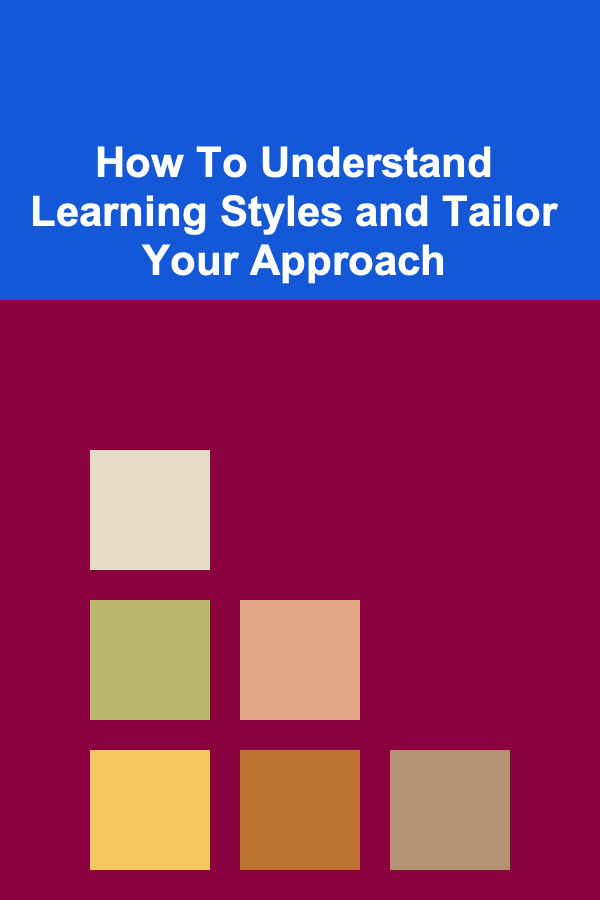
How To Understand Learning Styles and Tailor Your Approach
ebook include PDF & Audio bundle (Micro Guide)
$12.99$9.99
Limited Time Offer! Order within the next:

Understanding learning styles is essential for anyone engaged in teaching, tutoring, or personal learning. Over the years, researchers and educators have discovered that people absorb, process, and retain information in different ways. The theory of learning styles suggests that identifying an individual's preferred method of learning can help tailor teaching approaches, leading to more effective and engaging learning experiences.
In this article, we will dive deep into the concept of learning styles, exploring different models, their implications for education, and practical ways to adapt your learning approach based on these insights. Whether you're a student aiming to optimize your study techniques or an educator looking to enhance your teaching methods, understanding learning styles can be a transformative tool.
What Are Learning Styles?
Learning styles refer to the concept that individuals have distinct preferences for how they absorb, process, and retain new information. The theory proposes that by identifying these preferences, people can tailor their learning experiences to improve effectiveness and retention. While various models exist, all share the central premise that there is no one-size-fits-all approach to learning.
The most widely discussed models of learning styles include:
- VARK Model: Visual, Auditory, Reading/Writing, and Kinesthetic
- Gardner's Multiple Intelligences: A broader, more inclusive view of how people learn, involving different areas of intelligence like linguistic, logical-mathematical, spatial, etc.
- Kolb's Learning Styles: A model that categorizes learners into four styles based on their preferences for experiencing, reflecting, thinking, and acting.
VARK Model: Visual, Auditory, Reading/Writing, Kinesthetic
The VARK model is one of the most popular ways of categorizing learning styles. Developed by Neil Fleming, it breaks down learners into four main categories based on their primary mode of intake and processing information. Let's explore these categories:
2.1. Visual Learners
Visual learners tend to absorb information best when it is presented in a visual format. These learners are drawn to images, diagrams, charts, and written text. When they study, they often benefit from seeing concepts, and they might find it easier to remember information when it is linked to a visual representation.
Teaching Strategies for Visual Learners:
- Use diagrams, charts, and mind maps to explain concepts.
- Provide written instructions or handouts with key points and visual aids.
- Encourage students to use color coding in notes or assignments.
- Use videos or infographics to present complex information.
- Suggest that students visualize concepts or "picture" information in their minds.
2.2. Auditory Learners
Auditory learners thrive when information is presented through sound. They often prefer listening to lectures, discussions, podcasts, and audio resources. These learners tend to have strong verbal skills and often benefit from repeating information aloud or discussing ideas with others.
Teaching Strategies for Auditory Learners:
- Encourage verbal explanations and discussions.
- Use podcasts or audiobooks for supplementary learning.
- Incorporate rhythm or rhyme to help with memorization.
- Allow auditory learners to participate in group discussions or study groups.
- Encourage reading aloud or recording their thoughts on topics.
2.3. Reading/Writing Learners
This group of learners excels with written material. They prefer to take notes, write essays, and read articles, books, and reports. These learners often gravitate toward text-based resources and find it helpful to rewrite information or make lists to organize their thoughts.
Teaching Strategies for Reading/Writing Learners:
- Provide written resources such as articles, textbooks, and written summaries.
- Encourage note-taking and rewriting key points in their own words.
- Suggest that students write down questions and answers to solidify concepts.
- Use outlines and lists as organizational tools.
- Encourage reading and summarizing written material regularly.
2.4. Kinesthetic Learners
Kinesthetic learners, often referred to as tactile learners, learn best through physical movement and hands-on experiences. These learners prefer engaging in activities that involve touch, manipulation, and action. For kinesthetic learners, learning through practice and direct experience is crucial.
Teaching Strategies for Kinesthetic Learners:
- Use experiments, hands-on activities, and role-playing scenarios.
- Encourage movement during study sessions (walking while studying, for example).
- Use physical objects or props to demonstrate concepts.
- Allow learners to take breaks and move around while learning.
- Create simulations or real-life applications of the material.
Gardner's Multiple Intelligences
Howard Gardner, a Harvard psychologist, expanded the idea of learning styles through his theory of multiple intelligences. He proposed that humans possess a variety of cognitive abilities, or "intelligences," each with its own distinct way of processing and understanding the world. Unlike the VARK model, which focuses on sensory preferences, Gardner's model includes a broad range of abilities, from linguistic intelligence to interpersonal intelligence.
3.1. Linguistic Intelligence
People with strong linguistic intelligence excel in reading, writing, and verbal communication. They are good at storytelling, writing essays, or engaging in debates.
3.2. Logical-Mathematical Intelligence
This type of intelligence is marked by strong reasoning, problem-solving, and numerical skills. People with this intelligence are often good at mathematics, logic puzzles, and scientific exploration.
3.3. Spatial Intelligence
Spatial intelligence refers to the ability to visualize and manipulate objects in space. Artists, architects, and engineers are often strong in this area.
3.4. Musical Intelligence
Individuals with musical intelligence are sensitive to sound, rhythm, and music. They may excel in playing musical instruments, singing, or composing.
3.5. Bodily-Kinesthetic Intelligence
This intelligence refers to physical movement and coordination. People who excel in this area are often athletic or good with physical tasks, like dancers or surgeons.
3.6. Interpersonal Intelligence
Interpersonal intelligence is the ability to understand and interact effectively with others. People with high interpersonal intelligence are often good leaders, therapists, or educators.
3.7. Intrapersonal Intelligence
This intelligence involves self-awareness and the ability to understand one's own emotions, motivations, and desires. People with strong intrapersonal intelligence are often reflective and self-reliant.
3.8. Naturalistic Intelligence
This type of intelligence involves a deep understanding of the natural world. Biologists, conservationists, and environmentalists are often strong in naturalistic intelligence.
Gardner's model suggests that a more comprehensive understanding of learners requires an assessment of their multiple intelligences rather than just focusing on a single preference.
Kolb's Learning Styles
David Kolb's model of learning styles is based on the experiential learning theory, which suggests that people learn best through a cycle of concrete experience, reflective observation, abstract conceptualization, and active experimentation. Kolb categorizes learners into four types, depending on their preferred modes of learning and processing information.
4.1. Diverging (Concrete Experience, Reflective Observation)
Diverging learners are imaginative and sensitive. They excel in brainstorming, considering multiple perspectives, and thinking about possibilities. They often prefer learning through personal experiences and observing how things unfold.
4.2. Assimilating (Abstract Conceptualization, Reflective Observation)
Assimilating learners excel in logic and reasoning. They prefer structured learning environments and excel at creating theories and models from abstract concepts.
4.3. Converging (Abstract Conceptualization, Active Experimentation)
Converging learners are problem-solvers who excel at applying theories to practical problems. They prefer hands-on tasks and thrive in environments where they can experiment and find solutions to real-world problems.
4.4. Accommodating (Concrete Experience, Active Experimentation)
Accommodating learners are hands-on, action-oriented individuals. They enjoy learning through trial and error and are often quick to adapt to new experiences or situations.
Tailoring Your Approach to Different Learning Styles
Now that we've discussed various models of learning styles, it's essential to consider how you can adapt your approach to make learning more effective.
5.1. Personalized Learning for Students
For educators, personalizing the learning experience for each student is crucial. Understanding a student's preferred learning style can help you create customized learning plans that cater to their strengths. Here are some ways you can personalize learning:
- Identify Learning Preferences Early: Conduct an assessment or survey to identify students' learning preferences. This will help you understand whether they are visual, auditory, kinesthetic learners, or if they lean toward specific intelligences.
- Incorporate Different Modalities: Use a variety of instructional methods. For example, supplement a lecture with visual aids, interactive exercises, and group discussions to cater to multiple learning styles.
- Encourage Self-Reflection: Encourage students to reflect on their learning preferences and experiment with different methods to see what works best for them. For instance, a visual learner might try taking notes using color-coding or diagrams.
5.2. Strategies for Self-Learning
As a self-learner, understanding your own learning style is equally important. Here are some strategies you can use:
- Experiment with Different Learning Techniques: If you're unsure about your learning style, experiment with various methods---read textbooks, listen to lectures, take hands-on notes, or engage in activities---and see which techniques result in better retention and understanding.
- Create a Learning Environment: Set up your learning environment to support your preferred learning style. If you're a visual learner, ensure that your study area is filled with visual aids. If you are kinesthetic, take regular breaks and engage in physical activities while studying.
- Utilize Technology: There are various apps and tools available that can help tailor learning experiences to different styles. For example, visual learners can use mind-mapping apps, while auditory learners might benefit from audio-based study aids like podcasts or speech-to-text software.
5.3. Flexibility in Teaching Methods
If you're teaching a group, recognize that not all students will learn the same way. It's crucial to remain flexible and diversify your teaching methods to address the diverse learning styles within the class. While some students might respond well to lectures, others might need hands-on experiences or interactive group activities to grasp the material.
Conclusion
Understanding learning styles is an essential component of both teaching and learning. By recognizing the various ways individuals absorb and process information, we can tailor our approaches to maximize engagement, retention, and overall effectiveness. Whether you're a student looking to optimize your study habits or an educator aiming to enhance your students' learning experiences, understanding learning styles can be a game-changer.
The key is not to rigidly label people based on one style, but rather to provide a diverse and flexible environment that supports all types of learners. By doing so, we can create learning experiences that are both effective and engaging for everyone involved.

How to Convert a Home into a Profitable Rental Property
Read More
How to Deal with Lost and Found Situations in the Wilderness
Read More
How to Winterize Your Home to Prevent Damage from Cold Weather
Read More
How to Use Music Therapy for Relaxation
Read More
How To Prevent Heartburn Naturally
Read More
How to Prepare Healthy & Flavorful Dressings
Read MoreOther Products

How to Convert a Home into a Profitable Rental Property
Read More
How to Deal with Lost and Found Situations in the Wilderness
Read More
How to Winterize Your Home to Prevent Damage from Cold Weather
Read More
How to Use Music Therapy for Relaxation
Read More
How To Prevent Heartburn Naturally
Read More